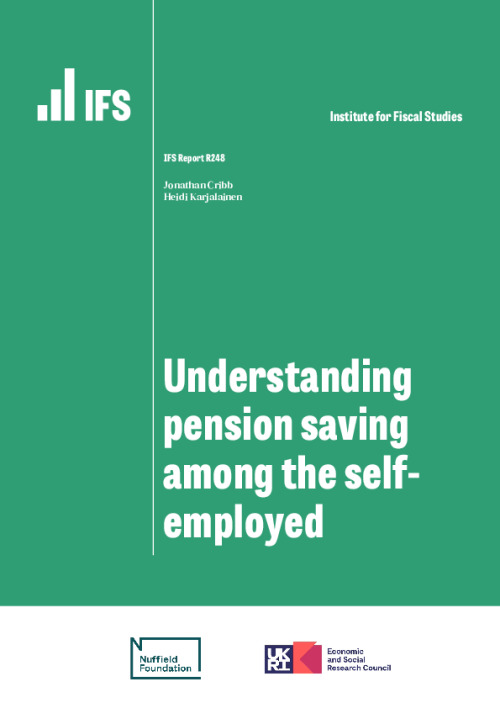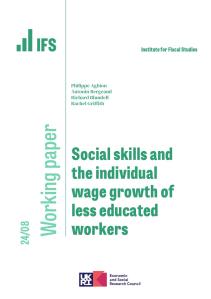Private pension saving among the self-employed population in the UK has been falling dramatically over the last few decades, and this has led to a heightened policy focus on how to boost pension saving among this group. In this report we analyse patterns of private pension saving among the self-employed using administrative tax data. We focus on a specific group of the self-employed – those who are working-age (age 22–64), long-term self-employed (self-employed for at least five consecutive years) and have no income from a job as an employee.
Key findings
1. Private pension participation among the self-employed has been falling over time. Amongst the long-term working-age self-employed, it fell from 33% in 2005–06 to only 14% in 2014–15. This compares with 57% of working-age private sector employees saving in a workplace pension in 2014–15 (and 81% in 2020–21).
2. Some of the self-employed will be well served in retirement by the state pension: about a third had incomes below £10,000 per year in 2014–15, and a full single-tier pension is now worth almost that amount. However, the differences in incomes between the self-employed and private sector employees cannot fully explain the differences in pension participation rates between these two groups. Comparing pension participation rates of the self-employed and private sector employees across the earnings distribution, we find that in 2014–15 the pension participation rate among the self-employed was lower than among employees at all earnings levels above £5,000 per year.
3. The gap between pension participation rates of private sector employees and the self-employed of the same earnings has widened since the introduction of automatic enrolment, especially among those on low to middle earnings. In 2014–15, the pension participation rate among employees earning £30,000 per year was around 60%, compared to 20% among self-employed workers of the same earnings level.
4. Self-employed people tend to have more volatile incomes than employees, and it has been argued that this can lead to a pattern where the self-employed switch into and out of pension saving based on whether they are having a ‘good’ or a ‘bad’ income year. We find that having more volatile income is associated with an increased likelihood of both leaving and entering pension saving. However, we do not find evidence for the self-employed moving regularly into and out of pension saving over time – over a 5-year period, 87% do not change their pension participation status between years.
5. Nearly a quarter of the self-employed who are saving into a pension choose the amount to save as a monthly or annual round number in nominal pound terms, with the most common (modal) amount being £50 per month (or £600 per year). This is in contrast to employees who most commonly choose their contribution level based on a percentage of earnings. Choosing round amounts is more common among the lower-earning self-employed, with more than a third of those with the lowest earnings saving round numbers, compared with 13% of those with earnings around £100,000. This suggests that those with fewer financial resources and potentially lower levels of financial knowledge are more likely to choose their level of contributions this way.
6. Many of the self-employed who save in a pension rarely change the nominal contribution amounts they make – nearly half (49%) of those saving in two consecutive years are saving the same amount a year later. Among those who are still saving in a pension 9 years later, close to a quarter (23%) save the same amount in cash terms. Similar to the pattern we saw with saving round nominal amounts, saving exactly the same amount year after year is more common among those with lower incomes. The round and constant cash contributions amounts do not seem to correspond to constant cash incomes – the distribution of contributions expressed as percentage of income appears smooth.
7. Of those who continue saving into a pension over time, those who were initially saving a round amount in cash terms are even more likely to be saving the same amount several years later. Sixty per cent of these people are still saving exactly the same cash amount nine years later. Over the period we study, this implied a 20% fall in the real value of contributions. With current high inflation rates, that fall would now be far larger.
8. We study whether the pension saving behaviour of the self-employed responds to the change in the upfront incentive to save into a pension at the higher-rate tax threshold. We find that the change in the tax incentive to save in a private pension increases pension participation among the self-employed by 3 percentage points around the higher-rate tax threshold, from a base level participation rate of about 40%. We also find an average increase in saving of £100 per year among those saving in a private pension, from an average contribution level of £2,000 per year around the higher-rate tax threshold. While these responses are sizeable, in particular in comparison to employees, the magnitude of these effects suggests that this specific upfront tax incentive alone is unable to deliver a large increase in pension saving among the self-employed.
9. The low levels of pension participation among self-employed workers mean that the key policy challenge for the government at the moment is to encourage people to engage with the private pension system and start saving into a pension. This is particularly true for those of the self-employed who are self-employed for larger parts of their working lives, as they will have less opportunity to save in a workplace pension and therefore risk not having adequate resources in retirement otherwise.
10. Overall, the findings from this report, as well as existing research, suggest that in order to increase the pension participation rates of self-employed workers meaningfully, new innovations on how to incorporate pension saving defaults for the self-employed as part of the tax system are needed. However, given that a large proportion of the self-employed are very low earners, any pension saving policies for the self-employed should make sure to target those of the self-employed who can actually afford to make contributions and are at most risk of seeing a large decline in their living standards at retirement in the absence of private saving.
11. Among the self-employed savers, the fact that the cash value of contributions is unchanged year after year implies that a form of auto-escalation could be a good way to boost their pension savings, for example using a direct debit that increased in line with inflation, or at another pre-set rate. This would help to ensure that contributions do not fall in real terms over time.











